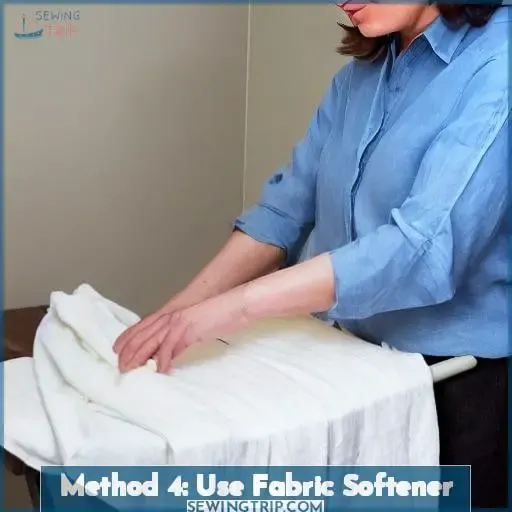This site is supported by our readers. We may earn a commission, at no cost to you, if you purchase through links.
Linen shirts can be a dream to wear. Their lightweight, breathable fabric is perfect for warm days and cool nights, but all too often they come out of the washer stiff as a board. Don’t despair! There are several ways you can soften your linen shirt so it feels comfortable against your skin like a soothing breeze on a hot day.
Put down the ironing board and pick up some white vinegar or baking soda. It’s time to show your linen shirt how much you care! Here are seven methods to help you get those crisp fibers back in line.
- Wash your linen shirt separately from other fabrics.
- Use a mild detergent.
- Do not use fabric softener.
- Rinse with cold water.
- Hang to dry.
- If necessary, use a steamer.
- For extra softness, add a half cup of white vinegar or a half cup of baking soda to the wash cycle.
With a bit of tender loving care, your linen shirt will be soft and comfortable in no time!
Table Of Contents
Method 1: Use White Vinegar
To soften your linen shirt, try using white vinegar instead of detergent. Wash in cold water and air dry for best results. To speed up the process, hang or line dry. For extra softness, add ½ cup vinegar to the wash cycle and use dryer balls at low heat during the final spin cycle. This will reduce wrinkles and give you a silky soft texture! Regular washing with white vinegar and proper care, such as air-drying or hang-drying, will make your shirt softer and last longer.
Method 2: Use Baking Soda
Try adding a cup of baking soda to your next wash cycle – you’ll be surprised at the results! It’s an effective way of removing additives and starch from new fabrics that make them stiff and rough. This option is also great if vinegar doesn’t have the desired effect on your linen garments – plus it’s non-toxic, so it won’t irritate sensitive skin or damage delicate colors.
Ironing: Use low heat when ironing after washing with baking soda as high temperatures may cause discoloration in some fabrics.
Air Drying: Hang air dry instead of putting into a dryer machine as this will prevent shrinkage and ensure maximum softness.
Fabric Starching: Avoid starching while using this method as it will affect the softness.
Steam Pressing: Use steam pressing instead to get rid of wrinkles without losing any quality in fabric fibers.
Hand Washing: You can hand wash heavily starched linens with 1/4 cup baking powder added to warm water for best results.
With these simple steps, you should have no problem achieving soft quality linen every time!
Method 3: Use Dryer Balls
You can transform your linen shirt by tossing in a few dryer balls. They provide the perfect blend of softness and airiness, and are an effective solution to soften up your linen without using harsh detergents or fabric softeners. Unlike wool balls, dryer balls are made of plastic and contain no chemicals, so they won’t leave residue on your garments like traditional dryer sheets.
To use them correctly, set the temperature setting on low and add a cup of white vinegar during the rinse cycle. You can also add different kinds of detergent if needed, as this will help loosen fibers faster. Once finished, throw in two or three (depending on size) into the tumbler along with some laundry items such as towels. This helps disperse heat evenly throughout all fabrics, ensuring maximum efficiency while still protecting delicate linens from any wrinkles due to ironing technique. After the drying process is done, your linen shirt will be soft and airy.
Method 4: Use Fabric Softener
Don’t put traditional fabric softener in your laundry when trying to make the linen shirt softer – it won’t work! Instead, try air-drying and ironing lightly to soften the material. If that doesn’t do the trick, soak your linen clothing overnight in cold water and hand wash with a mild detergent before line drying.
Try not to use fabric softener as this can add an odd scent or residue that isn’t ideal for a crisp looking garment. Remember: although using traditional fabric softeners might seem like an easy solution, they may actually damage your linens if used regularly over time!
So take extra care when caring for those precious garments; air dry them or iron lightly for best results—so you can get maximum wear out of them while still keeping it super comfortable and looking great—it’s all about mastering how to soften linen shirts!
Method 5: Use a Fan
Using a fan to dry your linen shirt can help reduce wrinkles and bring out its natural softness. After washing, soak it in cold water for an hour. Avoid using traditional fabric softener as this may affect its texture or add unwanted scent.
Hang on hangers with clothespins or lay flat on a clean surface. Aim a fan at them until they’re dried off – don’t use tennis balls, as these may damage fragile materials like linens.
Ironing might help, but only if necessary, as heat causes further shrinkage. If pre-soaked properly, though, it won’t have much effect. Adjust washing temperature accordingly when soaking garments first.
Method 6: Wash Your Linen Shirt Multiple Times
Washing your linen shirt over and over again may seem like a chore, but it’s actually the best way to look good! Repeated washing is key to softening and relaxing the fabric.
For a relaxed fit, wash your shirts in hot water with white vinegar added during both washes. After the first cycle, air dry or use cold water for a second wash cycle before drying completely. Temperature control helps ensure minimal wrinkles.
You don’t need much detergent – just enough to dissolve dirt particles from previous wearings. Natural ingredients like baking soda will help accelerate the softening process without damaging fabrics or introducing harsh chemicals into your wardrobe.
Linen sweaters can be softened by repeating this same method multiple times until desired texture is achieved. Patience is key, as results won’t be instantaneous. But with regular maintenance, you’ll see an amazing difference in how much softer and more comfortable these garments become!
Method 7: Use a Combination of Methods
By combining a few of the methods listed here, you can quickly and effectively give your linen shirt that vintage look without sacrificing its softness.
Set your washing machine to a gentle cycle and use half cup of white vinegar instead of detergent.
Afterward, air dry it in warm air or set the temperature on low when ironing for best results.
You may also try some natural softeners like baking soda or fabric enzyme-based pre-treatment solutions. These will help accelerate linen’s softness with constant exposure over time.
Use dry cleaning tips like stain removal processes before laundering, and ironing basics like adjusting temperatures accordingly for better results.
Use lower heat settings when ironing.
Air dry after first wash to prevent shrinkage.
Add baking soda during laundry cycles.
Don’t use traditional fabric softener.
Soak in a solution made from white vinegar and water.
Frequently Asked Questions (FAQs)
How often should I wash my linen shirt?
To keep your linen shirt feeling its best, wash it regularly. How often? A good rule of thumb: every three or four wears. To do it right, use cold delicate settings and add 1/4 cup of water per full washing machine load. For extra softness, use baking soda instead of soap. When drying, opt for low temperatures and ironing techniques to maintain crispness. With these tips, you’ll be able to soften it without compromising quality!
How long should I soak linen clothing in a vinegar and water solution?
Soaking your linen clothing in a solution of vinegar and water can be an effective way to soften it. However, you must take care not to overdo it. Soaking time should depend on the concentration of the vinegar used, as well as how soft you’d like your fabric to be. Too much soaking may lead to damage from acidity or weaken fibers, so keep an eye out for any signs of wear or tear.
For best results with wrinkle reduction and overall softening quality, consider steam ironing after washing with cool water and no chemical softeners. A stone wash will also work wonders!
Will ironing my linen shirt make it softer?
Ironing your linen shirt can make it softer – but pay attention to temperature and fabric type. Check washing directions for best results. Take humidity levels into account when selecting ironing temp. Don’t over-iron – this may damage the textile and reduce its softness. To get the best results, ensure linen is washed after its first wash. Air drying or using dryer balls can help too!
Is there a way to prevent my linen shirt from wrinkling?
Ironing your linen shirt is one way to prevent it from wrinkling. Steaming or wetting the fabric can help too, as can starching and using an ironing spray. The texture of a stiff tailored linen shirt should soften after each wash cycle in the dryer. You can also add tennis balls into your dryer for more softening – no extra cost!
Can I use traditional fabric softener on linen?
Ironing your linen shirt can help soften it, but traditional fabric softener should not be used. Instead, use natural softeners such as white vinegar and baking soda when washing the garment. Air drying is also recommended after a cold rinse to prevent shrinkage and maintain crispness.
If you’re looking for an effortless summer getaway capsule wardrobe that won’t feel too stiff or rough to wear, then keep in mind this important piece of info: linen will become softer with each lot of washes if done correctly! Use these ironing tricks and soak time with natural softeners for best results – you’ll find your linen garments are even softer than before!
Conclusion
To soften a linen shirt, patience is key. Try different methods and find what works best for you. Don’t be afraid to experiment. ‘Practice makes perfect’, so don’t give up. With regular wear and washing, your shirt will become softer over time. So, keep trying until you find the perfect combination.













